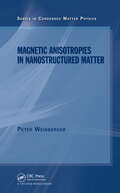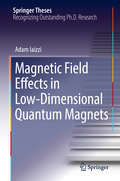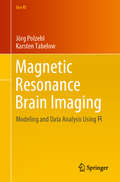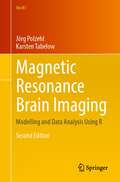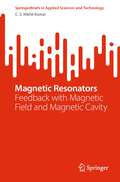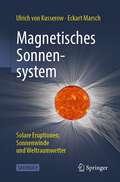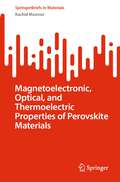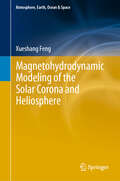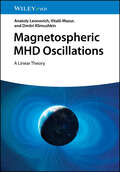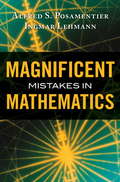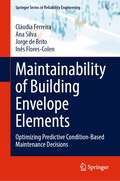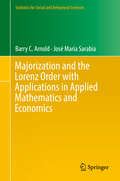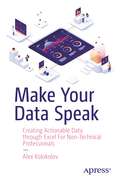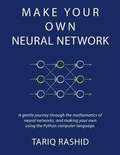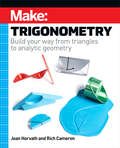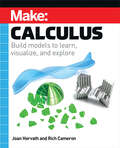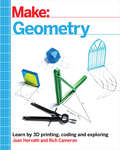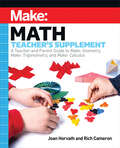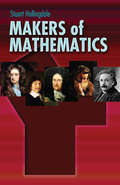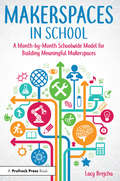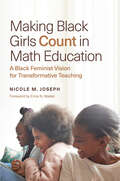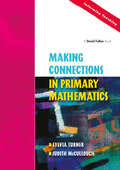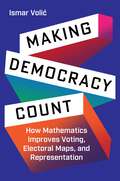- Table View
- List View
Magnetic Anisotropies in Nanostructured Matter (Condensed Matter Physics)
by Peter WeinbergerOne of the Top Selling Physics Books according to YBP Library ServicesMagnetic Anisotropies in Nanostructured Matter presents a compact summary of all the theoretical means to describe magnetic anisotropies and interlayer exchange coupling in nanosystems. The applications include free and capped magnetic surfaces, magnetic atoms on metallic substra
Magnetic Field Effects in Low-Dimensional Quantum Magnets (Springer Theses)
by Adam IaizziThis thesis is a tour-de-force combination of analytic and computational results clarifying and resolving important questions about the nature of quantum phase transitions in one- and two-dimensional magnetic systems. The author presents a comprehensive study of a low-dimensional spin-half quantum antiferromagnet (the J-Q model) in the presence of a magnetic field in both one and two dimensions, demonstrating the causes of metamagnetism in such systems and providing direct evidence of fractionalized excitations near the deconfined quantum critical point. In addition to describing significant new research results, this thesis also provides the non-expert with a clear understanding of the nature and importance of computational physics and its role in condensed matter physics as well as the nature of phase transitions, both classical and quantum. It also contains an elegant and detailed but accessible summary of the methods used in the thesis—exact diagonalization, Monte Carlo, quantum Monte Carlo and the stochastic series expansion—that will serve as a valuable pedagogical introduction to students beginning in this field.
Magnetic Resonance Brain Imaging: Modeling and Data Analysis Using R (Use R!)
by Jörg Polzehl Karsten TabelowThis book discusses the modeling and analysis of magnetic resonance imaging (MRI) data acquired from the human brain. The data processing pipelines described rely on R. The book is intended for readers from two communities: Statisticians who are interested in neuroimaging and looking for an introduction to the acquired data and typical scientific problems in the field; and neuroimaging students wanting to learn about the statistical modeling and analysis of MRI data. Offering a practical introduction to the field, the book focuses on those problems in data analysis for which implementations within R are available. It also includes fully worked examples and as such serves as a tutorial on MRI analysis with R, from which the readers can derive their own data processing scripts. The book starts with a short introduction to MRI and then examines the process of reading and writing common neuroimaging data formats to and from the R session. The main chapters cover three common MR imaging modalities and their data modeling and analysis problems: functional MRI, diffusion MRI, and Multi-Parameter Mapping. The book concludes with extended appendices providing details of the non-parametric statistics used and the resources for R and MRI data.The book also addresses the issues of reproducibility and topics like data organization and description, as well as open data and open science. It relies solely on a dynamic report generation with knitr and uses neuroimaging data publicly available in data repositories. The PDF was created executing the R code in the chunks and then running LaTeX, which means that almost all figures, numbers, and results were generated while producing the PDF from the sources.
Magnetic Resonance Brain Imaging: Modelling and Data Analysis Using R (Use R!)
by Jörg Polzehl Karsten TabelowThis book discusses modelling and analysis of Magnetic Resonance Imaging (MRI) data of the human brain. For the data processing pipelines we rely on R, the software environment for statistical computing and graphics. The book is intended for readers from two communities: Statisticians, who are interested in neuroimaging and look for an introduction to the acquired data and typical scientific problems in the field and neuroimaging students, who want to learn about the statistical modeling and analysis of MRI data. Being a practical introduction, the book focuses on those problems in data analysis for which implementations within R are available. By providing full worked-out examples the book thus serves as a tutorial for MRI analysis with R, from which the reader can derive its own data processing scripts.The book starts with a short introduction into MRI. The next chapter considers the process of reading and writing common neuroimaging data formats to and from the R session. The main chapters then cover four common MR imaging modalities and their data modeling and analysis problems: functional MRI, diffusion MRI, Multi-Parameter Mapping and Inversion Recovery MRI. The book concludes with extended Appendices on details of the utilize non-parametric statistics and on resources for R and MRI data.The book also addresses the issues of reproducibility and topics like data organization and description, open data and open science. It completely relies on a dynamic report generation with knitr: The books R-code and intermediate results are available for reproducibility of the examples.
Magnetic Resonators: Feedback with Magnetic Field and Magnetic Cavity (SpringerBriefs in Applied Sciences and Technology)
by C. S. Nikhil KumarThe phase-locking of multiple spin-torque nano oscillators(STNOs) is considered the primary vehicle to achieve sufficient signal quality for applications. This book highlights the resonator's design and its need for feedback for phase locking of STNOs. STNOs can act as sources of tunable microwaves after being phase-locked together. External feedback from a coplanar waveguide placed above an STNO helps ensures coherent single domain oscillations. STNOs placed within magnonic crystal cavities also demonstrate coherent oscillations. Arrays of such cavities provide a route to scale power levels from such nano-oscillators. The book presents numerical and micromagnetics to validate the design.
Magnetisches Sonnensystem: Solare Eruptionen, Sonnenwinde und Weltraumwetter
by Eckart Marsch Ulrich von KusserowDie magnetisch aktive Sonne steht im Zentrum unseres Sonnensystems. Aus ihrer Korona strömt der Sonnenwind stetig in alle Richtungen und formt eine großräumige magnetisierte Plasmahülle um unser Zentralgestirn: die Heliosphäre. Zusammen mit der aus dem Interstellaren Medium eindringenden kosmischen Partikelstrahlung prägt der Sonnenwind die Entwicklung des Weltraumwetters im Interplanetaren Raum sowie in den Magnetosphären und Ionosphären der Planeten. Wie entstehen Kometenschweife und Polarlichter? Welchen Einfluss hat der Sonnenwind auf das Leben im Erdsystem?Unterstützt durch faszinierende Abbildungen astronomischer Himmelsobjekte, durch erklärende Grafiken, wissenschaftliche Originaldaten sowie durch die Verknüpfungshinweise zu Videosequenzen werden die zugrundeliegenden physikalischen Prozesse und neuesten Erkenntnisse didaktisch aufbereitet und mit wenigen mathematischen Herleitungen anschaulich erläutert. Dieses Sachbuch wendet sich allgemein an die gebildete Öffentlichkeit, an Amateurastronomen aber auch an junge Studierende, die sich einen umfassenden Überblick über die generelle Bedeutung magnetischer Vorgänge sowie ein tieferes Verständnis der Prozesse in den Weltraumplasmen unseres Sonnensystems verschaffen möchten.
Magnetoelectronic, Optical, and Thermoelectric Properties of Perovskite Materials (SpringerBriefs in Materials)
by Rachid MasrourThis book undertakes an extensive exploration of manganese-based compounds, such as T₁₋ₓSrxMnO₃ (T = La, Pr; x = 0.35, 0.25) using density functional theory and Monte Carlo simulations with a focus on understanding their electronic, magnetic, and magnetocaloric properties. Ba₁₋ₓSrxFeO₃ (x = 0, 0.2) is also studied via different approximations, offering a comparative perspective. In addition, the book looks at the influence of magnetism using Monte Carlo simulations, revealing crucial parameters and examining the GdCrO₃ system through DFT and Monte Carlo simulation, shedding light on recent experimental observations. Additionally, Monte Carlo studies investigate magnetic and magnetocaloric features of Sr₂FeMoO₆, La₂SrMn₂O₇ bilayer manganite, perovskite ferromagnetic thin films' surface effects, and SmFe₁₋ₓMnxO₃ perovskite. In essence, this book significantly advances our comprehension of magnetic and magnetocaloric phenomena across diverse materials and is well-suited for both experimentalists and computational researchers working in this field.
Magnetohydrodynamic Modeling of the Solar Corona and Heliosphere (Atmosphere, Earth, Ocean & Space)
by Xueshang FengThe book covers intimately all the topics necessary for the development of a robust magnetohydrodynamic (MHD) code within the framework of the cell-centered finite volume method (FVM) and its applications in space weather study. First, it presents a brief review of existing MHD models in studying solar corona and the heliosphere. Then it introduces the cell-centered FVM in three-dimensional computational domain. Finally, the book presents some applications of FVM to the MHD codes on spherical coordinates in various research fields of space weather, focusing on the development of the 3D Solar-InterPlanetary space-time Conservation Element and Solution Element (SIP-CESE) MHD model and its applications to space weather studies in various aspects. The book is written for senior undergraduates, graduate students, lecturers, engineers and researchers in solar-terrestrial physics, space weather theory, modeling, and prediction, computational fluid dynamics, and MHD simulations. It helps readers to fully understand and implement a robust and versatile MHD code based on the cell-centered FVM.
Magnetospheric MHD Oscillations: A Linear Theory
by Anatoly Leonovich Dmitri Klimushkin Vitalii MazurMagnetospheric MHD Oscillations A groundbreaking new theory of the magnetosphere The magnetosphere is the region around Earth in which our planet’s magnetic field exerts its influence to trap charged particles. Waves in this magnetosphere, known as magnetohydrodynamic (MHD) oscillations, are caused by interactions between these charged particles, Solar wind pulses, and the magnetic field. The predictable interval between these oscillations enables them to serve as tools for understanding the magnetospheric plasma which comprises the field. Magnetospheric MHD Oscillations offers a comprehensive overview of the theory underlying these waves and their periodicity. Emphasizing the spatial structure of the oscillations, it advances a theory of MHD oscillation that promises to have significant ramifications in astronomy and beyond. Magnetospheric MHD Oscillations readers will also find: Theorizing of direct relevance to current satellite missions, such as THEMIS and the Van Allen Probe In-depth discussion of topics including Alfven resonance, waveguides in plasma filaments, and many more Detailed appendices including key calculations and statistical parameters Magnetospheric MDH Oscillations is ideal for plasma physicists, theoretical physicists, applied mathematicians, and advanced graduate students in these and related subfields.
Magnificent Mistakes in Mathematics
by Alfred S. Posamentier Ingmar LehmannRequiring no more than high-school-level math competency, this playful excursion through the nuances of math will give you a better grasp of this fundamental, all-important science. Veteran math educators demonstrate how some "magnificent mistakes" had profound consequences for our understanding of mathematics' key concepts. In the nineteenth century, English mathematician William Shanks spent fifteen years calculating the value of pi, setting a record for the number of decimal places. Later, his calculation was reproduced using large wooden numerals to decorate the cupola of a hall in the Palais de la Découverte in Paris. However, in 1946, with the aid of a mechanical desk calculator that ran for seventy hours, it was discovered that there was a mistake in the 528th decimal place. Today, supercomputers have determined the value of pi to trillions of decimal places. This is just one of the amusing and intriguing stories about mistakes in mathematics in this layperson's guide to mathematical principles. In another example, the authors show that when we "prove" that every triangle is isosceles, we are violating a concept not even known to Euclid-that of "betweenness." And if we disregard the time-honored Pythagorean theorem, this is a misuse of the concept of infinity. Even using correct procedures can sometimes lead to absurd-but enlightening-results.
Maintainability of Building Envelope Elements: Optimizing Predictive Condition-Based Maintenance Decisions (Springer Series in Reliability Engineering)
by Ana Silva Jorge de Brito Inês Flores-Colen Cláudia FerreiraThis book introduces a maintenance model that will assist decision-makers in their choice of building maintenance policies. The model is stochastic and condition-based that analyses the impact of different maintenance strategies on the durability and performance of different buildings envelope elements (facades, windows, and roofs). As non-structural elements, the maintenance of buildings envelope can be disregarded stakeholders. However, as first barrier to the external environment, these elements are critical to buildings' overall performance and are expected to meet aesthetic, comfort, safety, and durability requirements. The methodology presented is innovative. The maintenance model is based on a Petri net formalism and includes degradation, inspection, maintenance, and renewal processes. The model provides key information, such as: i) the impact of different maintenance strategies on the service life and durability of the building components; ii) the impact of maintenance on their performance over time; iii) the life cycle costs; and iv) the impact of maintenance on the buildings' use. The book will be of use to a variety of professionals in the construction sector.
Majeshir Ganit class 1 - NCERT - 23: मजेशीर गणीत वर्ग १ - एनसीईआरटी - २३
by National Council of Educational Research and Trainingइयत्ता पहिलीसाठी आनंददायी गणित या पाठ्यपुस्तकातील आशय NCF-FS 2022 मध्ये नमूद केलेल्या पुढील चार घटकांवर आधारित आहे तोंडी गणित चर्चा, कौशल्य शिकवणे, कौशल्य सराव आणि गणिती खेळ सर्व अध्यायांमध्ये समाविष्ट केले गेले आहेत. त्यापैकी बहुतेक एकात्मिक पद्धतीने सादर केले आहेत. तथापि, खालील प्रकरणे केवळ गणितीय समज आणि क्षमता विकसित करण्याच्या अभ्यासक्रमाच्या उद्दिष्टाशी (CG-8) आणि परिमाणे, आकार आणि मापे यांद्वारा जग ओळखू शकण्याशीच संरेखित नाहीत तर NCF-FS 2022 मध्ये दिलेल्या सर्वांगीण विकासाकडे नेणाऱ्या इतर सर्व अभ्यासक्रम व अभ्यासक्रमिय उद्दिष्टांशीदेखील सरेखित आहेत - मौखिक गणित चर्चा, कौशल्यशिक्षण, कौशल्यसराव आणि गणिती खेळ. बौद्धिक आव्हान आणि विचारप्रवर्तक कार्यांमुळे गणिताचे अध्ययन व निर्णयनक्षमता अधिक चांगल्या प्रकारे होते. मेंदूला सतावणारे प्रश्न, कोडी, कूट प्रश्न यामुळे नेहमीच्या शिकण्याच्या जोडीने मुलांना याची संधी मिळते. मुलांच्या वयाला साजेशी अनेक कोडी या पुस्तकात दिली आहेत.
Majeshir Ganit class 2 - NCERT - 23: मजेशीर गणीत वर्ग २ - एनसीईआरटी - २३
by National Council of Educational Research and Trainingइयत्ता दुसरीसाठी असलेले आनंददायी गणित असे नाव असलेले गणिताचे पाठ्यपुस्तक NEP 2020, NCF-FS 2022 तसेच पायाभरणीच्या टप्प्यासाठीचा अभ्यासक्रम यांच्या शिफारसी डोळ्यासमोर ठेवून तयार केले आहे। बालवाटिका 1 ते 3 तसेच पहिली झाल्यावर (3-8 वर्षे वयात) दुसरीत जाणाऱ्या मुलाला अंकांचे ज्ञान झालेले असते, असे यात गृहीत धरले आहे। परंतु, आपल्या देशातील विविधता बघता, कदाचित काही मुलांची एकदम शाळेत पहिलीत गेल्यावरच पहिल्यांदा अंकांची ओळख होत असेल, असेही होऊ शकते। हे क्रमिक पुस्तक तयार करताना अशा परिस्थितीचाही विचार केलेला आहे। वयाच्या या टप्प्यावरील मुले मुक्तपणे खेळणे, खेळणी यात रमतात। हे लक्षात घेऊन, अवकाशीय समज, अंकहाताळणी, गणितीय आणि संगणकीय संकल्पना इ। शिकवण्यासाठीच्या उपक्रमांमध्ये खेळ, खेळणी यांचा वापर करण्यासाठी पुष्कळ वाव ठेवलेला आहे। यामुळे प्रत्येक नवीन संकल्पना किंवा कौशल्य शिकताना मूर्त वस्तूंकडून चित्रस्वरूपाकडे व त्याकडून अमूर्त कल्पनांपर्यंतचे संक्रमण सहजपणे होऊ शकते। सर्वांगीण विकासासाठी अनुभवातून शिक्षण हे उद्दिष्ट डोळ्यासमोर ठेवून, इयत्ता दुसरीसाठी असलेल्या आनंददायी गणित या पुस्तकामध्ये, वर्गात आणि वर्गाबाहेर करण्यासारखे अनेक उपक्रम दिले आहेत। यातील सर्व प्रकरणांमध्ये, उपक्रमाधारित कार्यांच्या माध्यमातून गणितीय संकल्पनांचे आकलन करून दिले आहे। सक्तीने, नाखुषीने गणित शिकण्याऐवजी, आपण खेळ खेळत आहोत अशा भावनेने मुलांनी हे उपक्रम करावेत आणि त्याद्वारे गणितीय संकल्पना आपोआप रुजाव्यात, अशा प्रकारचे वातावरण निर्माण करण्याचा प्रयत्न या पुस्तकातून केलेला आहे।
Majorization and the Lorenz Order with Applications in Applied Mathematics and Economics (Statistics For Social And Behavioral Sciences Ser.)
by Barry C. Arnold Jose Maria SarabiaThis book was written to serve as a graduate-level textbook for special topics classes in mathematics, statistics, and economics, to introduce these topics to other researchers, and for use in short courses. It is an introduction to the theory of majorization and related notions, and contains detailed material on economic applications of majorization and the Lorenz order, investigating the theoretical aspects of these two interrelated orderings. Revising and expanding on an earlier monograph, Majorization and the Lorenz Order: A Brief Introduction, the authors provide a straightforward development and explanation of majorization concepts, addressing historical development of the topics, and providing up-to-date coverage of families of Lorenz curves. The exposition of multivariate Lorenz orderings sets it apart from existing treatments of these topics.Mathematicians, theoretical statisticians, economists, and other social scientists who already recognize the utility of the Lorenz order in income inequality contexts and arenas will find the book useful for its sound development of relevant concepts rigorously linked to both the majorization literature and the even more extensive body of research on economic applications. Barry C. Arnold, PhD, is Distinguished Professor in the Statistics Department at the University of California, Riverside. He is a Fellow of the American Statistical Society, the American Association for the Advancement of Science, and the Institute of Mathematical Statistics, and is an elected member of the International Statistical Institute. He is the author of more than two hundred publications and eight books.José María Sarabia, PhD, is Statistics Professor in the Department of Economics at the University of Cantabria, Spain. He is author of more than one hundred publications and ten books and is an associate editor of several journals, including Journal of Banking and Finance, TEST, and Journal of Statistical Distributions and Applications.
Make Your Data Speak: Creating Actionable Data through Excel For Non-Technical Professionals
by Alex KolokolovGather and analyze data successfully, identify trends, and then create overarching strategies and actionable next steps - all through Excel. This book will show even those who lack a technical background how to make advanced interactive reports with only Excel at hand. Advanced visualization is available to everyone, and this step-by-step guide will show you how.The information in this book is presented in an accessible and understandable way for everyone, regardless of the level of technical skills and proficiency in MS Excel. The dashboard development process is given in the format of step-by-step instructions, taking you through each step in detail. Universal checklists and recommendations of a practicing business analyst and trainer will help in solving various tasks when working with data visualization. Illustrations will help you perceive information easily and quickly. Make Your Data Speak will show you how to master the main rules, techniques and tricks of professional data visualization in just a few days.What You'll LearnSee how interactive dashboards can be useful for a businessReview basic rules for building dashboardsUnderstand why it's important to pay attention to colors and fonts when developing a dashboardCreate interactive management reports in Excel Who This Book is ForCompany executives and divisional managers, Middle managers, business analysts
Make Your Own Neural Network
by Tariq Rashid<P>A step-by-step journey through the mathematics of neural networks, and making your own using the Python computer language.<P> Neural networks are a key element of deep learning and artificial intelligence, which today is capable of some truly impressive feats.<P> Yet too few really understand how neural networks actually work. <P>This guide will take you on a fun and unhurried journey, starting from very simple ideas, and gradually building up an understanding of how neural networks work.
Make: Build your way from triangles to analytic geometry
by Joan Horvath Rich CameronTrigonometry has 2000-year-old roots in everyday useful endeavors, like finding the size of an object too big or far away to measure directly, or navigating from Point A to Point B. However, it is often taught very theoretically, with an emphasis on abstractions. Make: Trigonometry uses 3D printable models and readily-available physical objects like wire and cardboard tubes to develop intuition about concepts in trigonometry and basic analytic geometry. Readers will imagine the thought process of the people who invented these mathematical concepts, and can try out "math experiments" to see for themselves how ingenious ancient navigators and surveyors really were.The analytic geometry part of the book links equations to many of these intuitive concepts, which we explore through in-depth explanations of manipulative models of conic sections. This book is aimed at high school students who might be in Algebra II or Pre-Calculus. It shows the geometrical and practical sides of these topics that otherwise can drown in their own algebra.Make: Trigonometry builds on the basics of the authors' earlier book, Make: Geometry, and is intended as a bridge from that book to their Make: Calculus book. The user can read this book and understand the concepts from the photographs of 3D printable models alone. However, since many models are puzzle-like, we encourage the reader to print the models on any consumer-grade filament based 3D printer. The models are available for download in a freely-available open source repository. They were created in the free program OpenSCAD, and can be 3D printed or modified by the student in OpenSCAD to learn a little coding along the way.
Make: Calculus
by Joan Horvath Rich CameronWhen Isaac Newton developed calculus in the 1600s, he was trying to tie together math and physics in an intuitive, geometrical way. But over time math and physics teaching became heavily weighted toward algebra, and less toward geometrical problem solving. However, many practicing mathematicians and physicists will get their intuition geometrically first and do the algebra later.Make:Calculus imagines how Newton might have used 3D printed models, construction toys, programming, craft materials, and an Arduino or two to teach calculus concepts in an intuitive way. The book uses as little reliance on algebra as possible while still retaining enough to allow comparison with a traditional curriculum.This book is not a traditional Calculus I textbook. Rather, it will take the reader on a tour of key concepts in calculus that lend themselves to hands-on projects. This book also defines terms and common symbols for them so that self-learners can learn more on their own.
Make: Learn by coding, 3D printing and building
by Joan Horvath Rich CameronGeometry, of all the branches of mathematics, is the one that is most easily visualized by making something. However, it is all too easy to reduce it to reams of formulas to memorize and proofs to replicate. This book aims to take geometry back to its practical roots with 3D printed models and puzzles as well as demonstrations with household objects like flashlights and paper towel tubes.This is not a traditional geometry textbook, but rather builds up understanding of geometry concepts while also bringing in elements of concepts normally learned much later. Some of the models are counterintuitive, and figuring out how and why they work will both entertain and give insights. Two final chapters suggesting open-ended projects in astronomy and physics, and art and architecture, allow for deeper understanding and integration of the learning in the rest of the book.
Make: Math Teacher's Supplement
by Joan Horvath Rich CameronMake: Math Teacher's Supplement is the essential guide for teachers, parents, and other educators wanting to supplement their curriculum with Joan Horvath and Rich Cameron's Make: Geometry, Make: Trigonometry, and Make: Calculus books.This book is a companion to the three math books, and does not duplicate the content in them. Drawing on the authors' experience guiding both students and teachers, it covers:The philosophy behind the Make: math book series, including the key inclusion of universal design principles to make the material accessible to those who learn differently A list of topics, projects, and needed maker skills, tied to the math book chapters Key learning objectives and associated assessment ideas A practical primer on 3D printing in an educational environment Helpful tips to manage student 3D printed workflow Five specific examples of ways to use content from the math books, including studying geometry with castles and using LEGO bricks to demonstrate calculus conceptsPacked with tips and links to online resources, Make: Math Teacher's Supplement will let you see how to build math intuition to create a solid base for your learner's future.
Makers of Mathematics
by Stuart HollingdaleFascinating and highly readable, this book recounts the history of mathematics as revealed in the lives and writings of the most distinguished practitioners of the art: Archimedes, Descartes, Fermat, Pascal, Newton, Leibniz, Euler, Gauss, Hamilton, Einstein, and many more. Author Stuart Hollingdale introduces and explains the roles of these gifted and often colorful figures in the development of mathematics as well as the ways in which their work relates to mathematics as a whole.Although the emphasis in this absorbing survey is primarily biographical, Hollingdale also discusses major historical themes and explains new ideas and techniques. No specialized mathematical knowledge on the part of the reader is assumed. Superbly informative, this volume offers an accessible, interesting guide to one of the pillars of modern science, and to a supremely important aspect of human culture through the ages.
Makerspaces in School: A Month-by-Month Schoolwide Model for Building Meaningful Makerspaces
by Lacy BrejchaOrganized into an easy-to-follow, month-by-month plan for implementation, this book provides field-tested and research-based knowledge that will serve educators as they create and maintain a meaningful Makerspace. Although science, technology, engineering, arts, and math have made huge gains in the past decade, STEAM jobs are not being filled at the rate they are being created or needed. Makerspaces in School promotes innovative thinking in students that fills this need. Through Makerspaces, project-based learning provides opportunities for credible, legitimate, and authentic growth and development. This book will allow any educator to walk away with a plan to create a Makerspace in his or her classroom or a school- or districtwide model that works for many. Makerspaces are very fluid places—each is unique in its own way!2020 Teachers' Choice Award for Professional Development Winner
Making Black Girls Count in Math Education: A Black Feminist Vision for Transformative Teaching
by Nicole M. JosephMaking Black Girls Count in Math Education explores the experiences of Black girls and women in mathematics from preschool to graduate school, deftly probing race and gender inequity in STEM fields.Nicole M. Joseph investigates factors that contribute to the glaring underrepresentation of Black female students in the mathematics pipeline. Joseph&’s unflinching account calls attention to educational structures and practices that contribute to race- and gender-based stratification in science, technology, engineering, and mathematics disciplines. The author also disentangles a complex network of historical and sociopolitical elements that influence the perception and experiences of Black girls and women both inside and outside of mathematics education.In her clear-eyed assessment of the intersectional difficulties facing this marginalized group, Joseph offers a critical view of the existing mathematics education research, practice, and policies that have neglected Black girls and women; confronts the problematic history of mathematics education policy; and considers imbalances in the current teacher workforce in US mathematics programs. She then provides practical, actionable suggestions for reform.Joseph invites students, families, and educators, as well as researchers, policy makers, and other relevant stakeholders to disrupt systems, structures, and ideologies. She calls for an end to racism and sexism in many areas of mathematics education, including learning environments, curriculum design and implementation, and testing and assessments.An essential read for anyone concerned about supporting the mathematical learning and development of Black girls and women, this work advocates for coalition-building so that greater, more equitable opportunities for learning and engagement may be offered to Black female students.
Making Connections in Primary Mathematics: A Practical Guide
by Sylvia Turner Judith McCullochFirst published in 2004. Routledge is an imprint of Taylor & Francis, an informa company.
Making Democracy Count: How Mathematics Improves Voting, Electoral Maps, and Representation
by Ismar VolićHow we can repair our democracy by rebuilding the mechanisms that power itWhat’s the best way to determine what most voters want when multiple candidates are running? What’s the fairest way to allocate legislative seats to different constituencies? What’s the least distorted way to draw voting districts? Not the way we do things now. Democracy is mathematical to its very foundations. Yet most of the methods in use are a historical grab bag of the shortsighted, the cynical, the innumerate, and the outright discriminatory. Making Democracy Count sheds new light on our electoral systems, revealing how a deeper understanding of their mathematics is the key to creating civic infrastructure that works for everyone.In this timely guide, Ismar Volić empowers us to use mathematical thinking as an objective, nonpartisan framework that rises above the noise and rancor of today’s divided public square. Examining our representative democracy using powerful clarifying concepts, Volić shows why our current voting system stifles political diversity, why the size of the House of Representatives contributes to its paralysis, why gerrymandering is a sinister instrument that entrenches partisanship and disenfranchisement, why the Electoral College must be rethought, and what can work better and why. Volić also discusses the legal and constitutional practicalities involved and proposes a road map for repairing the mathematical structures that undergird representative government.Making Democracy Count gives us the concrete knowledge and the confidence to advocate for a more just, equitable, and inclusive democracy.
